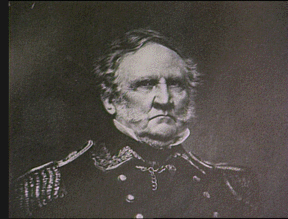![]()

Born in 1786 near Petersburg, Virginia, Winfield Scott's father was a successful farmer who had served in the Revolutionary War. His mother came from a wealthy Virginia family. Though both his parents died when he was young, Scott's inheritance was modest. He studied for a short time at William and Mary College before undertaking the study of law in Petersburg. He practiced law and served in the army in the period prior to the War of 1812. With the outbreak of the War of 1812, Scott recruited a regiment and was promoted to the rank of lieutenant colonel. He served on the northern front, and his bravery and energy brought him honors and promotion, as he was brevetted a major general.
After the war, Scott studied European military methods, wrote on military and other subjects, and took up headquarters in New York City. He returned to active duty with the Black Hawk War in 1832, and was commissioned by President Andrew Jackson to proceed to South Carolina to watch over the nullification movement. Other military actions involved the controversial Seminole and Creek conflict in 1835, in which he clashed with Jackson, and a more celebrated role in restoring tranquility on the Canadian border during Martin Van Buren's presidency. Owing to his prominence as a military leader as well as a potential Whig presidential candidate, Scott was made general-in-chief of the army in 1841.
It was the Mexican War that brought Scott lasting renown. He was ordered to Mexico in November 1846. Obstructed by poorly equipped troops, limited reinforcements and supplies, desertions, and disease, Scott nevertheless undertook a successful five-month campaign from Vera Cruz to Mexico City. But feuds generated by ambitious subordinate officers and, especially, the hostility of the Polk administration to further honoring a Whig general, led to Scott's recall and replacement. In addition, a court of inquiry was established to investigate Scott's actions in disciplining those disloyal officers. The charges against Scott were eventually dropped, and Congress voted him its thanks and a gold medal. In 1852, Congress passed a measure offering Scott the pay, rank, and emoluments of a lieutenant general, the first person to hold that office since George Washington. That same year, he was the Whig Party's unsuccessful candidate for President.
As the secession crisis developed during the latter part of 1860, Scott pleaded unsuccessfully to President James Buchanan to reinforce the southern forts and armories against possible seizure. He brought his headquarters from New York to Washington, D.C., so that he could oversee the recruiting and training of the capital's defence. He personally commanded Abraham Lincoln's bodyguard at the inauguration. Now seventy-five years old, Scott requested retirement, and in November 1861, he was retired. Five years later, he died at West Point and was buried in the national cemetery there.
A large and imposing figure, Scott as a young man stood six feet, five inches tall and weighed 230 pounds. His career was extraordinarily long, some fifty years, and he was the associate of every President from Thomas Jefferson to Lincoln. Called "Fuss and Feathers" because of his punctiliousness in dress and decorum, his reputation for patriotism and generosity generally won him the trust and loyalty of his troops.